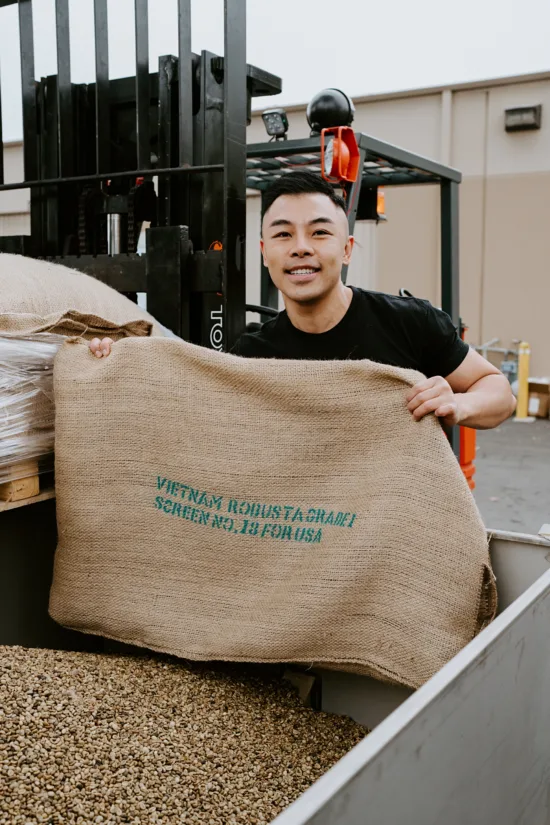
Rising from the ashes of the Vietnam War’s destruction, Vietnam has emerged as a heavy hitter in coffee production.
BY EMILY JOY MENESES
BARISTA MAGAZINE ONLINE
Featured photo courtesy of Vince Nguyen
Welcome back to “Cup of Resilience—How Robusta Revived Vietnam’s Economy After the Vietnam War.” In this article series, we’re discussing the resurgence of Vietnamese coffee production after a decades-long conflict.
In part one, we discussed the origins of Vietnamese coffee, and how the use of chemicals like napalm and Agent Orange devastated the Southeast Asian country’s land, including coffee fields. Today, we’ll discuss how the country transformed its coffee industry into what it is today, and how robusta coffee helped revitalize the Vietnamese economy.

Vietnam as a Major Player in the Global Coffee Market
By the 1990s, Vietnam’s coffee industry had transformed into a global powerhouse. In 1998, the government introduced the 5 Million Hectare Reforestation program, an extensive reforestation and development plan in the country’s mountainous regions, through which coffee production would quickly surge. Vietnam became the world’s second-largest coffee producer, behind only Brazil, with robusta beans accounting for a significant portion of its exports.
Today, Vietnam’s influence in coffee is expanding beyond quantity. Vietnamese robusta beans are gaining recognition within the specialty-coffee industry, appealing to those looking for new and diverse flavors. Vince Nguyen, founder of Los Angeles-based Nam Coffee, describes the evolution of robusta’s reputation. “Now, Vietnam is one of the biggest coffee producers in the world, and robusta is making a comeback in specialty-coffee circles. It’s wild to think how far things have come.”
Sahra Nguyen of Nguyen Coffee Supply has also been vocal over the past few years about the resurgence of robusta coffee and its importance to the Vietnamese economy. She says that though robusta coffee has been excluded from specialty coffee for decades, it has served as a lighthouse for farmers in Vietnam working to revive their country after the war.

Vietnamese Coffee in the West: Preserving Tradition Abroad
Vince Nguyen’s Los Angeles-based shop, Nam Coffee, serves as both a café and cultural bridge, bringing authentic Vietnamese coffee to American audiences. He explains, “I wanted Nam Coffee to be more than just a coffee shop—it’s about connection, community, and making people feel seen.”
For Vince, this mission reflects not just his heritage but also the spirit of Vietnamese coffee culture, which emphasizes slowness and connection.
The shop also offers an educational experience for patrons, many of whom are unfamiliar with robusta coffee’s strong and earthy taste. “Being one of the few Vietnamese coffee spots in L.A. is exciting but also comes with a sense of responsibility,” Vince says. “I think people are curious about it, and when they walk in, we get to introduce them to something new, which is rewarding. Seeing their reaction to that first sip of strong, slow-dripped coffee with condensed milk—that’s the magic right there.”

The Resilience of Tradition in Vietnam
Today, Vietnamese coffee continues to evolve, finding new audiences globally while maintaining its cultural roots. Vince Nguyen hopes to inspire others to recognize Vietnamese coffee as more than just a beverage, but as a tradition rooted in resilience. As he says, “Vietnamese coffee isn’t just about caffeine—it’s cultural. It’s about slowing down, sitting with people, and really savoring the moment. A lot of people think of coffee as this fast-paced thing, but in Vietnam, it’s the opposite. It’s a lifestyle.”
Throughout its journey over the past few decades, Vietnamese coffee has come to symbolize the country’s tenacity. From the slow-drip coffee shared in family households to the brews served in Vietnamese coffee shops around the world, Vietnamese coffee stands as a tribute to the strength and spirit of its homeland.
ABOUT THE AUTHOR
Emily Joy Meneses (she/they) is a writer and musician based in Los Angeles. Her hobbies include foraging, cortados, vintage synths, and connecting with her Filipino roots through music, art, food, and beverage.
Subscribe and More!
As always, you can read Barista Magazine in paper or digital format. Read the October + November 2024 issue for free with our digital edition.
And for more than three years’ worth of issues, visit our digital edition archives here.





